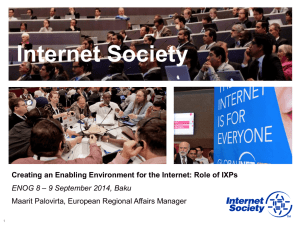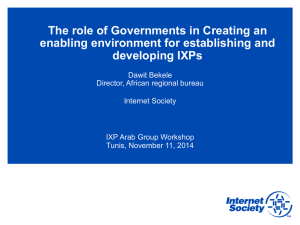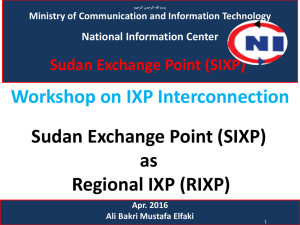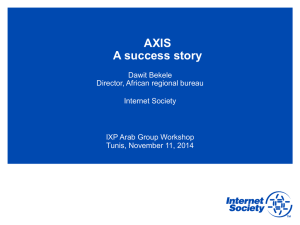Overview of recent changes in the international IP interconnection ecosystem
advertisement
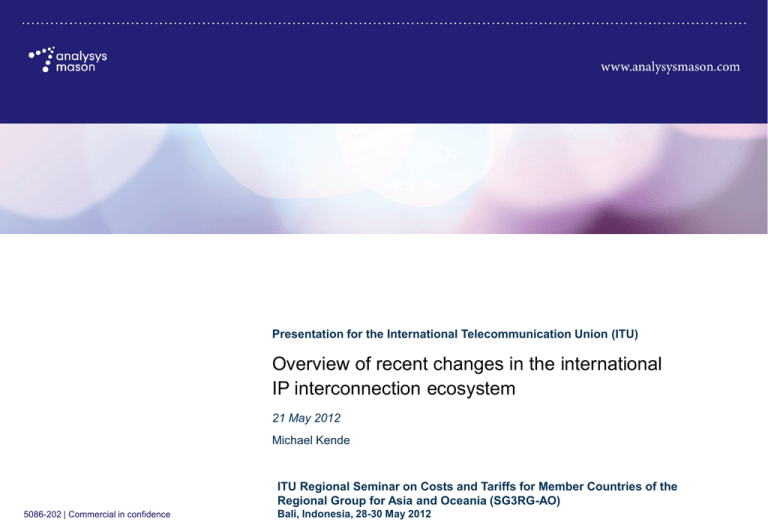
Presentation for the International Telecommunication Union (ITU) Overview of recent changes in the international IP interconnection ecosystem 21 May 2012 Michael Kende ITU Regional Seminar on Costs and Tariffs for Member Countries of the Regional Group for Asia and Oceania (SG3RG-AO) 5086-202 | Commercial in confidence Bali, Indonesia, 28-30 May 2012 2 Introduction Last year marked the 15th anniversary of the commercialization of the Internet backbone. This paper focuses on two underlying trends since then: the Internet has globalized, first from the US to the rest of the developed world, and then beyond to emerging markets Internet traffic has increased by many orders of magnitude, based both on the increased numbers of users as well as the increasing amount of premium content including video The paper describes how interconnection arrangements have evolved in response to these trends: Internet exchange points (IXPs) have helped to localize traffic and increase the efficiency of the Internet countries with successful IXPs have transitioned from accessing Internet traffic as a ‘spoke’ to becoming a ‘hub’ for traffic in other countries we highlight successful case studies and policies that countries can adopt to become a hub, and the impact for countries without those policies 5086-202 | Commercial in confidence 3 The commercial Internet is relatively young The National Science Foundation Network (NSFNET) backbone service was decommissioned in favor of the commercial Internet on April 15, 1995: the NSFNET was used by regional networks to exchange traffic in its place, four network access points (NAPs) across the country were designated for traffic exchange interconnection was not regulated – in its place commercial arrangements known as peering and transit were negotiated between different providers ISP 1 Backbone Network A Backbone Network B Settlementfree transit, paid transit, or peering The Internet was much different on that day: Netscape had just been introduced the NSFNET backbone was just 45Mbit/s the Internet was very US-centric 5086-202 | Commercial in confidence ISP 2 4 In 1995 the Internet was very US-centric for a number of reasons The US was the historical home of the Internet: 70% of Internet users were in the US in 1995, along with much of the content up to 60% of European traffic routed through the US Much of the European traffic was tromboning through the US back to Europe: all European ISPs had to connect to the US to access users and content anyway the lack of liberalization in Europe made national and inter-European links very expensive for direct connections. For instance, in 1998 leased lines prices for a 2 Mbit/s link were London – Paris: $38,000 / month London – Virginia: $30,000 / month In addition to tromboning, the European traffic to the US had two sources: accessing content (including European content that was hosted in the US) natural traffic flows between the US and Europe (e.g. email) 5086-202 | Commercial in confidence 5 The early Internet was a hierarchy with Internet backbones at the top Representation of relationships between Internet players in 1995 All traffic passes through the backbone providers, which carry the traffic between the ISPs Backbone 1 Content provider and aggregator End user ISP 2 ISP 1 NAP Backbone 3 ISP 4 Backbone 2 ISP 3 Internet access Transit Peering 5086-202 | Commercial in confidence Source: Analysys Mason 6 The Internet began to evolve quickly [1/2] Internet traffic trends by service Usage has changed significantly over the past ten years: 60,000 traffic used to be relatively static – text, email, file-sharing etc. Two trends are particularly relevant with respect to international traffic flows: applications such as voice over Internet Protocol (VoIP) are very sensitive to latency, but relatively low bandwidth applications such as video streaming are high bandwidth, but less sensitive to latency (with buffering) 5086-202 | Commercial in confidence Source: Cisco PB per month dynamic multimedia traffic now dominates with a significant amount of video and gaming 50,000 40,000 30,000 20,000 10,000 0 2008 2009 2010 2011 2012 2013 2014 2015 File sharing Web, email, and data Internet video Video calling Online gaming Voice over IP (VoIP) 7 The Internet began to evolve quickly [2/2] Evolution of Internet users by region 100% in 2000 Internet usage was heavily concentrated in developed countries, with a far higher percentage coming from the US and Canada then reflected in the population split 90% this reflected the greater availability of PCs and fixed access in developed countries 50% Population split 40% 30% 20% 10% 5086-202 | Commercial in confidence Source: ITU Asia 2010 2009 2008 2007 2006 2005 Europe Africa 2010 (pop.) US & Canada Latin America 2004 0% 2003 this results from mobile access, as well as greater availability of shared access 60% 2002 usage in Asia and Africa now more closely reflects the population split 70% 2000 The usage trend has shifted significantly in the past ten years: 80% 2001 Usage began to better reflect population distribution: 8 The historical architecture was not sustainable The US-centric approach imposed increasing costs: as developed countries liberalized, the cost of national and regional links fell relative to the cost of links to the US the latency of access through the US became increasingly noticeable The Internet began to outgrow the NAPs: traffic was exchanged via public peering, involving a shared switch that soon congested as traffic volumes began to multiply the owners of the NAPs included operators who were not perceived as neutral in selling access There were three changes in the architecture: interconnection evolved from NAPs to IXPs the IXPs began to develop outside the US some countries sought a policy response to pricing (e.g. ICAIS) 5086-202 | Commercial in confidence 9 Interconnection migrated from NAPs to IXPs IXPs emerged in place of NAPs: a wide variety of activities are possible, including direct peering and the sale of transit these are large data centers open to all parties including ISPs and content providers IXPs address the issues raised by NAPs: IXPs are neutral, and many are non-profit associations owned and operated by their members, housed within larger commercial data centers (such as owned by Equinix) within the data center, large providers use direct cross-connects to engage in private peering to avoid congestion IXPs also act to flatten the hierarchy of the Internet: the data center hosts content providers and ISPs who can use the IXP to peer directly with one another the members of the IXP can also purchase domestic or international transit services within the data center 5086-202 | Commercial in confidence 10 Content also began to migrate to IXPs High-bandwidth content tends to be ‘portable’: Traffic shares by application according to Cisco, over 96% of content consists of video, file sharing, and web pages unlike voice, such content can be moved from the origination point New technology such as caches allow content to be distributed: entire websites or popular pages can be stored closer to end users this lowers the bandwidth costs while also improving quality of service content distribution networks (CDNs) such as Akamai will manage content on behalf of providers IXPs provide a natural location to store content where it can be efficiently accessed by multiple ISPs 5086-202 | Commercial in confidence Source: Cisco 17% 34% 45% File sharing Internet video Web, email, and data Video calling Online gaming Voice over IP (VoIP) Other 11 As a result of IXPs, the backbone is far less hierarchical today Representation of relationships between Internet players today Backbone 1 End-user ISP 2 Content provider and aggregator Backbone 3 Backbone 2 IXP IXP ISP ISP 4 ISP 3 5086-202 | Commercial in confidence Internet access Transit Peering Secondary peering Partial transit Paid peering Source: Analysys Mason 12 There have been three phases of globalization Number of IXPs by region US-Centric phase, for historical reasons starting with the commercialization of the Internet 400 350 OECD-Centric, focused on developed countries in Europe and Asia: 5086-202 | Commercial in confidence Source: Packet Clearing House, Analysys Mason 150 100 50 North America Europe Latin America Africa Asia 2011 2010 2009 2008 2007 2006 2005 2004 2003 2002 0 2001 in Africa only two countries had IXPs before 2002, which has risen to 20 by the end of 2010 200 2000 Rest of World (ROW) centric, focused on emerging markets: 250 1999 founded in 1994, it now connects more than 390 members, who own and operate the exchange as a non-profit Total number of IXPs the Amsterdam Internet Exchange (AMSIX) is a good example of a successful IXP. 300 13 The OECD-Centric phase has drastically reduced the reliance on the US in Europe and Asia U.S. & Canada Europe Asia Latin America Africa U.S. & Canada Europe Asia Latin America 2011 2010 2009 0% 2008 0% 2007 10% 2006 10% 2005 20% 2004 20% 2003 30% 2002 30% 1999 40% 2011 40% 2010 50% 2009 50% 2008 60% 2007 60% 2006 70% 2005 70% 2004 80% 2003 80% 2002 90% 2001 90% 2000 100% 1999 100% 2001 International Internet bandwidth from Asian countries, by region 2000 International Internet bandwidth from European countries, by region Africa The early IXPs in Europe were setup before 1999, significantly reducing tromboning before this dataset starts Asia had a later start in localizing traffic, but has now reduced reliance on the US for Internet bandwidth by half Nonetheless, the reliance on the US has now fallen to about 15% of bandwidth, while Asia is increasingly a destination Intra-Asian traffic has increased as more traffic localizes, while Europe is increasingly a destination for traffic exchange 5086-202 | Commercial in confidence Source: TeleGeography Global Internet Bandwidth 14 The ROW phase has not had as great an impact on international bandwidth to date U.S. & Canada Europe Asia Africa African reliance on the US for Internet bandwidth has reduced drastically However, the reliance has shifted to Europe, which demonstrates both the adaptability of the Internet structure but also the need for continued localization in Africa 5086-202 | Commercial in confidence Source: TeleGeography Global Internet Bandwidth U.S. & Canada Europe Asia Latin America 2011 2010 2009 0% 2008 0% 2007 10% 2006 10% 2005 20% 2004 20% 2003 30% 2002 30% 1999 40% 2011 40% 2010 50% 2009 50% 2008 60% 2007 60% 2006 70% 2005 70% 2004 80% 2003 80% 2002 90% 2001 90% 2000 100% 1999 100% 2001 International Internet bandwidth from Latin American countries, by region 2000 International Internet bandwidth from African countries, by region Africa Latin American reliance on the US has begun to fall, but is still above 80% Unlike the African situation, intra-regional traffic is growing, but still demonstrates the need for continued localization 15 A successful IXP can evolve from acting as a ‘spoke’ to a ‘hub’ IXP evolution No IXP IXP ‘spoke’ Content provider Content provider ISP 4 ISP 4 IXP ‘hub’ ISP 4 IXP IXP IXP International International International Country A Country A ISP 2 ISP 1 ISP 2 ISP 1 Country A ISP 1 Content provider IXP ISP 3 5086-202 | Commercial in confidence ISP 3 An IXP ‘spoke’ can quickly eliminate tromboning, but still accesses content and international transit abroad IXP ISP 2 ISP 3 An IXP ‘hub’ acts as a magnet for content and international backbones to sell services in the country and greater region 16 The evolution to IXP ‘hub’ may require broad policy changes, with corresponding benefits International Internet bandwidth per capita Creation of an IXP: there are many examples of ISPs acting together to create an IXP, with little or no regulatory intervention 600 the ability of that IXP to attract FDI and become a hub largely lies outside of the control of the IXP and likely even the regulator 400 first, foreign providers will look at the general business environment second, providers look at sector policies including international liberalization, and licensing requirements and obligations The impact of AMS-IX in the Netherlands is noticeable in terms of bandwidth per capita (see right) 5086-202 | Commercial in confidence Source: TeleGeography Global Internet Bandwidth kbit/s 300 200 100 0 2002 2003 2004 2005 2006 2007 2008 2009 2010 2011 Broadly speaking, two sets of factors impact the evolution of the IXP into a hub: 500 Australia Canada France UK USA Germany Singapore Netherlands 17 A recent study for the Internet Society shows the benefits of an IXP in developing countries An association of ISPs in Kenya (TESPOK) setup the Kenya Internet Exchange Point (KIXP) in Nairobi in early 2000: the immediate benefit was to eliminate reliance on satellite for tromboning, reducing latency and cost significantly the incumbent challenged the IXP with the regulator, but was ultimately denied The growth in the IXP has been significant: there are now 28 members peering at KIXP, including all major operators, a government network, and several DNS servers KIXP is one of the fastest growing IXPs in the world, peaking at up to 1Gbit/s traffic recently 5086-202 | Commercial in confidence The IXP of Nigeria (IXPN) was established in 2006 in Lagos: the stated objective was reducing reliance on international transit for exchanging local traffic between members The growth has been significant: there are now more then 30 members exchanging traffic in IXPN traffic peaks at over 300Mbit/s Growth has been slower than in Kenya: not all major operators are members and traffic levels are lower the key reason appears to be that the high cost of national backhaul restricts the benefits of avoiding international tromboning Source: Assessment of the impact of Internet Exchange Points – empirical study of Kenya and Nigeria, April 2012 18 The impact of having local content is particularly significant Traffic exchanged at KIXP Google installed a Google Global Cache (GGC) in Kenya: 1200 the cache was initially provided to one operator in Nairobi, under the condition that the contents would be made available to all members of KIXP 1000 the cache retains static content after it has been downloaded in Kenya, such as YouTube videos as shown on the right, traffic through KIXP spiked immediately this increase mostly reflects users’ increased usage of Google content, notably an increased willingness to stream YouTube videos based on lower latency of access mobile operators who charged by the MB experienced increased revenues along with lower costs 5086-202 | Commercial in confidence Source: KIXP, Analysys Mason Mbit/s The cache was installed in April 2011: 800 600 400 200 0 Mar-03 Dec-05 Sep-08 Jun-11 19 The benefits of the IXPs are broadly felt in Kenya and Nigeria Benefit KIXP IXPN Summary Latency Reduced from 200–600ms to 2–10ms Reduced from 200–400ms to 2–10ms Noticeable increase in performance for end users Local traffic exchange 1Gbit/s peak 300Mbit/s peak Savings on international transit of over $1 million per annum in each country Content Google network present locally, along with rehoming of domestic content Same as in Kenya Increase in usage and corresponding revenues for mobile data traffic e-government Kenya Revenue Authority gathers taxes online Usage by education and research networks Social benefits from egovernment access to IXPs Other benefits An increasing amount of regional traffic exchanged at KIXP Financial platforms hosted locally Further economic benefits resulting from IXPs 5086-202 | Commercial in confidence 20 The impact of Internet trends only highlights the need for Internet hubs in emerging markets The trend is towards an increasing reliance on Internet access and content: increasingly personal and business content and applications are moving into the cloud increasingly these are designed for access by mobile devices Policy solutions should focus on creating local hubs, rather than simply lowering the cost of acting as a spoke: as the bandwidth of access and content increases, international access costs will continue to rise in addition, access to local or regional hubs will reduce latency and improve the resiliency of access 5086-202 | Commercial in confidence Source: Analysys Mason Summary of Internet trends 21 Contact details Michael Kende michael.kende@analysysmason.com Cambridge Tel: +44 (0)845 600 5244 Fax: +44 (0)1223 460866 cambridge@analysysmason.com Manchester Tel: +44 (0)845 600 5244 Fax: +44 (0)161 877 7810 manchester@analysysmason.com Analysys Mason Limited Via Pietro Verri 6, First Floor 20121 Milan, Italy Dubai Tel: +971 (0)4 446 7473 Fax: +971 (0)4 446 9827 dubai@analysysmason.com Milan Tel: +39 02 76 31 88 34 Fax: +39 02 36 50 45 50 milan@analysysmason.com Dublin Tel: +353 (0)1 602 4755 Fax: +353 (0)1 602 4777 dublin@analysysmason.com New Delhi Tel: +91 11 4700 3100 Fax: +91 11 4700 3102 newdelhi@analysysmason.com Edinburgh Tel: +44 (0)845 600 5244 Fax: +44 (0)131 443 9944 edinburgh@analysysmason.com Paris Tel: +33 (0)1 72 71 96 96 Fax: +33 (0)1 72 71 96 97 paris@analysysmason.com London Tel: +44 (0)845 600 5244 Fax: +44 (0)20 7395 9001 london@analysysmason.com Singapore Tel: +65 6493 6038 Fax: +65 6720 6038 singapore@analysysmason.com Madrid Tel: +34 91 399 5016 Fax: +34 91 451 8071 madrid@analysysmason.com Washington DC Tel: +1 202 331 3080 Fax: +1 202 331 3083 washingtondc@analysysmason.com Partner 5086-202 | Commercial in confidence
